Readings Newsletter
Become a Readings Member to make your shopping experience even easier.
Sign in or sign up for free!
You’re not far away from qualifying for FREE standard shipping within Australia
You’ve qualified for FREE standard shipping within Australia
The cart is loading…






This title is printed to order. This book may have been self-published. If so, we cannot guarantee the quality of the content. In the main most books will have gone through the editing process however some may not. We therefore suggest that you be aware of this before ordering this book. If in doubt check either the author or publisher’s details as we are unable to accept any returns unless they are faulty. Please contact us if you have any questions.
It is well known that luminescence is the term used to describe the excess radiation from a body over and above the thermal radiation and persisting for a time which greatly exceeds the period of a light vibration. The first half of this definition, proposed by Wiedemann, distinguishes luminescence from equilibrium thermal radi ation; the second half, introduced by Vavilov, distinguishes luminescence from various forms of scattering and from induced radiation, such as Vavilov-Cherenkov radiation, etc. Distinctions are made between photo-, cathodo-, x-ray-, and other forms ofluminescence, depending on how energy is introduced into the luminescent body. Electroluminescence is the name given to that form of fluorescence in which the radiating body receives energy directly from an electric field. It should be noted that luminescence under the influence of cathode rays is not called electroluminescence, because in this case the necessary energy is not supplied directly from the electric field to the radiating body but by means of extraneous electrons. Electroluminescence of gaseous bodies (radiation from a gas discharge) has been known for a long time and is widely used in luminescent lamps and gas discharge tubes. In 1923 Losev [1J observed radiation from silicon carbide crystals when a voltage was applied to them di rectly.
$9.00 standard shipping within Australia
FREE standard shipping within Australia for orders over $100.00
Express & International shipping calculated at checkout
This title is printed to order. This book may have been self-published. If so, we cannot guarantee the quality of the content. In the main most books will have gone through the editing process however some may not. We therefore suggest that you be aware of this before ordering this book. If in doubt check either the author or publisher’s details as we are unable to accept any returns unless they are faulty. Please contact us if you have any questions.
It is well known that luminescence is the term used to describe the excess radiation from a body over and above the thermal radiation and persisting for a time which greatly exceeds the period of a light vibration. The first half of this definition, proposed by Wiedemann, distinguishes luminescence from equilibrium thermal radi ation; the second half, introduced by Vavilov, distinguishes luminescence from various forms of scattering and from induced radiation, such as Vavilov-Cherenkov radiation, etc. Distinctions are made between photo-, cathodo-, x-ray-, and other forms ofluminescence, depending on how energy is introduced into the luminescent body. Electroluminescence is the name given to that form of fluorescence in which the radiating body receives energy directly from an electric field. It should be noted that luminescence under the influence of cathode rays is not called electroluminescence, because in this case the necessary energy is not supplied directly from the electric field to the radiating body but by means of extraneous electrons. Electroluminescence of gaseous bodies (radiation from a gas discharge) has been known for a long time and is widely used in luminescent lamps and gas discharge tubes. In 1923 Losev [1J observed radiation from silicon carbide crystals when a voltage was applied to them di rectly.